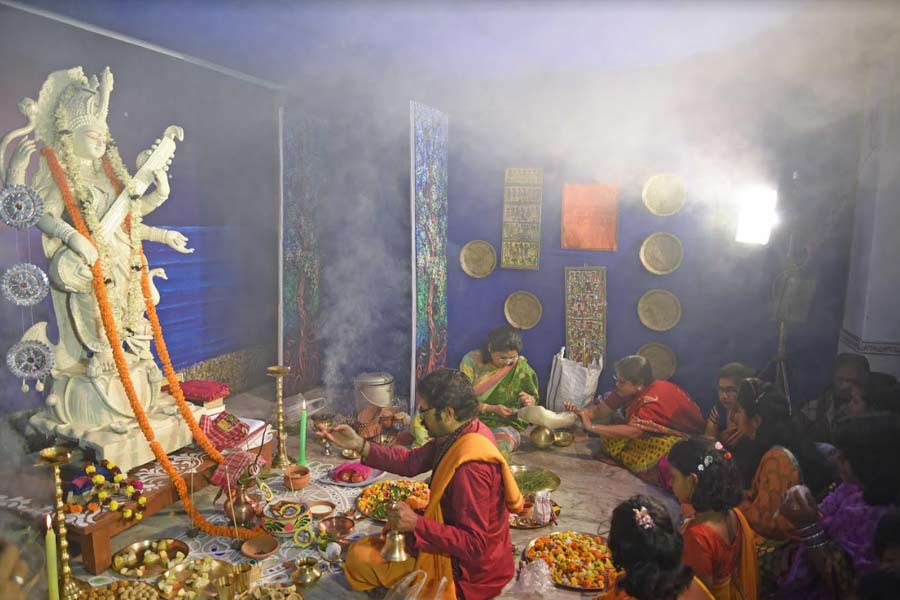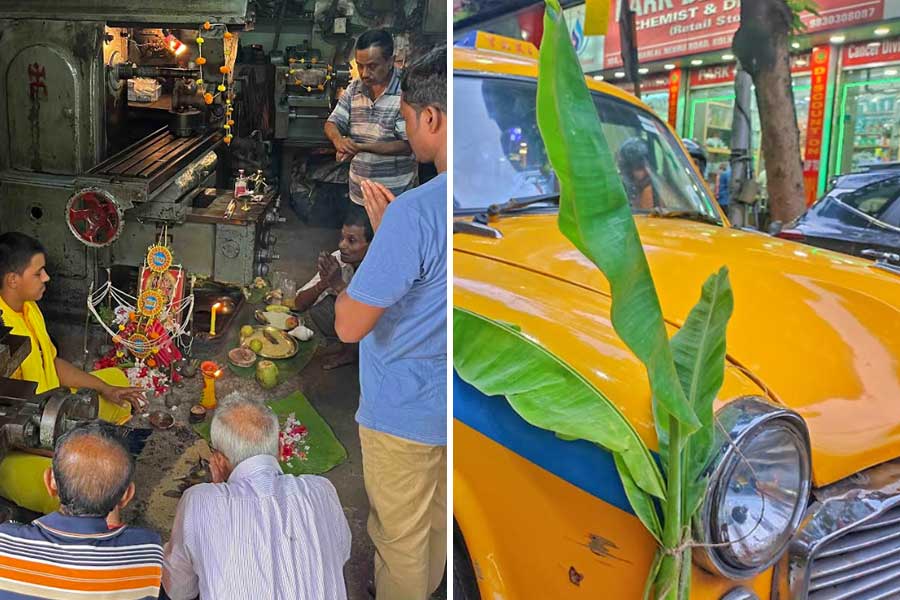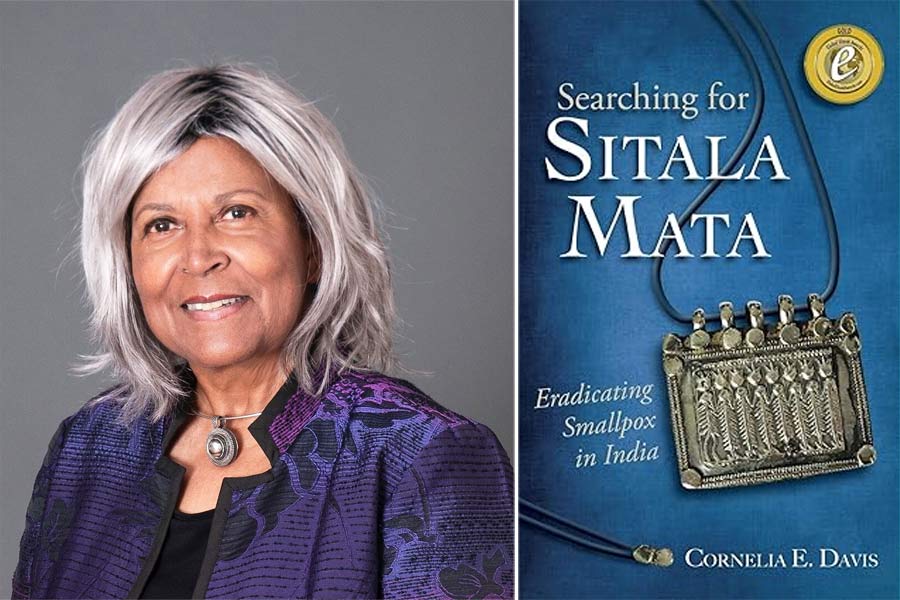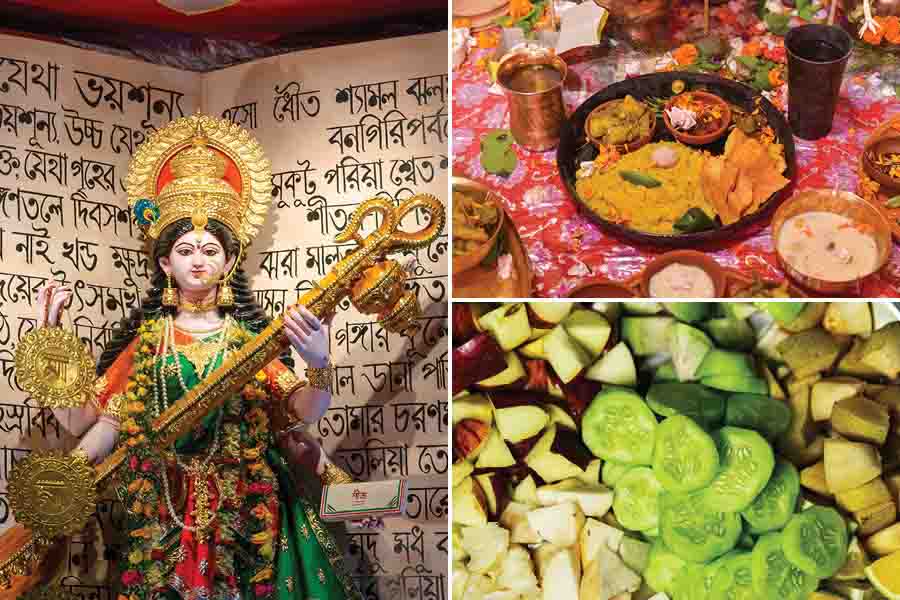On the day after Saraswati Puja, many homes across West Bengal have a unique culinary tradition — gota sheddho. The dish is made by simply cooking with oil and seasoning, a bounty of seasonal produce such as peas, broad beans, brinjal, along with tubers, greens like sheesh palong, and lentils. Everything is slow cooked or boiled — sheddho — and done so whole or gota, hence the name.
Homage to a nurturing goddess

In a temple near Bagbazar in Kolkata, an idol of Ma Shashthi, who is believed to be the goddess of fertility, protector of children
Wikimedia CommonsThe Rarh region of West Bengal is colloquially known as Ghotir desh, referring to the regions where families from epar Bangla (historically West Bengal, as opposed to opar Bangla, which refernce to modern-day Bangladesh) reside. Across this region in southwest Bengal, comprising Murshidabad, Burdwan, Birbhum, Medinipur and Bankura, the advent of spring is marked by eating gota sheddho on Shashthi Puja, a festival dedicated to Shashthi Devi. However, all across Bengal, Devi Shashthi is worshipped throughout the year in multiple forms, such as Aranya Shashthi, etc. In Bihar and Mithilanchal, Shashthi Devi is revered as Chhathi Maiya and Chhath Puja is dedicated to her.

The Sashthi Puja following Vasant Panchami or Saraswati Puja is known at Sital Shashthi
Amit DattaThe Shashthi Puja that follows Saraswati Puja or Vasant Panchami is known as Sital or Sitala Shashthi. The food offerings made on Sital Shashthi are often cooked the previous day and eaten unheated a day later, as opposed to hot and freshly cooked food, which is generally the norm. It is an aberration that is sure to pique one’s curiosity. However, a trip back in time is sure to provide some context.
A culinary tradition born of social challenges

A painting of Shashthi Devi by an unidentified artist from Kolkata circa 1885, from the collection of Victoria and Albert Museum, London
Wikimedia CommonsThough called Sitala Shashthi, the festive day is not in honour of Ma Sitala. Shashthi Devi is revered as a goddess of fertility, reproduction, the benefactor and protector of children, a saviour from infectious diseases, as well as a symbol of agricultural prosperity. She is worshipped throughout the year on the sixth day of the shukla paksha or waxing fortnight of the moon, and each puja is characterised in a slightly different way. Sitala Shashthi is one of the 12 puja rituals for Shashthi Devi in the Bengali calendar, explained food and cultural studies scholar, Chitrita Banerji.
In a historical context, the cusp of winter and spring also coincides with an increase in the number of cases of pox. Earlier, it was believed that consuming cold food would bring down body temperature, hence providing relief to patients of smallpox. The tradition of offering cold food to the goddess and eating the same as prasad later can be tied to this phenomenon. As per modern medical science, while cold food temporarily reduces the temperature of the mouth, it has no effect on the core body temperature of the patient.

Among the rituals that involve an offering of cold, cooked food is the ‘arandhan’ ritual of Vishwakarma Puja, which celebrates Vishwakarma, who is known as the architect of the gods
Suvendu DasAccording to Banerji, the ritual of eating cold food cooked on the previous day happens more than once in the Hindu calendar, in and out of Bengal, and not all the occasions are associated with health and immunity. On Ambubachi (first day of rain) for instance, widows start a cold food diet for several days. The day of Vishwakarma Puja in autumn is also a day of arandhan, when no utensils can be used — also a way to give the women of the household a break from their everyday labour.
A page from the history of smallpox in India
In 1974, a virulent smallpox epidemic wreaked havoc across Rajasthan, Uttar Pradesh, Madhya Pradesh, Bihar, and West Bengal. A triumphant vaccination programme led to its eradication in 1977. Among the numerous medical professionals who volunteered, were Dr. Mary Guinan and Dr. Cornelia E. Davis. Dr. Davis, at that time had just completed her Paediatric Residency programme and responded to a call by WHO, setting out to India. Her predecessor Dr. Guinan had a tougher challenge. Her application to join the eradication program was rejected twice, because at that time WHO wasn’t accepting women doctors in the programme. However, Guinan pursued the matter with then prime minister Indira Gandhi and WHO authorities, and was finally allowed a three-month stay. Post her departure, the region she worked for was declared free of smallpox. Her contribution was a great success and paved the way for Davis’s entry to India.

Dr. Cornelia E. Davis documented her experiences of working on eradicating smallpox in India in her book ‘Searching for Sitala Mata’
Davis stayed for two years and led the massive mission. Till date, smallpox is the only human disease to have been eradicated from the world. She penned her experiences in a book, Searching for Sitala Mata. In it, she recounts her time in India during the immunisation drive facing challenges like battling prejudice, lack of refrigeration, remote locations, all while overcoming barriers of language, caste, colour, and gender as an African American woman. What is interesting is that she also makes references to the custom of eating cold food, and how different goddesses were worshipped with a belief of them holding the power to cure certain diseases.
Gratitude or thanksgiving is the core essence of Indian culture, marked by festivals, fairs, rituals, and worship. Each bite of gota sheddho I have is dedicated to the innumerable healthcare professionals who are the modern-day incarnation of Shashthi Ma.
Srishti Sensarma is a recent graduate of MA Food Studies from New York University where she focused on food and culture. She is currently in Kolkata, conducting research on Bengali cuisine and modern day Bengali kitchens.









